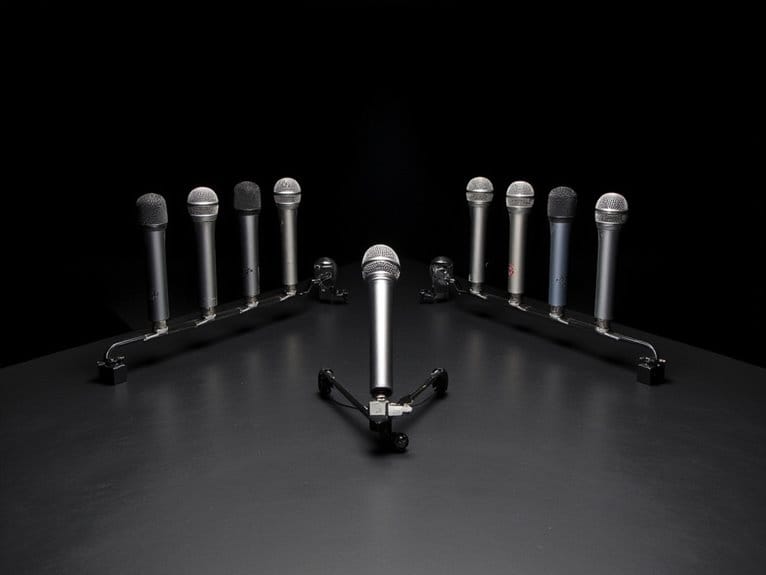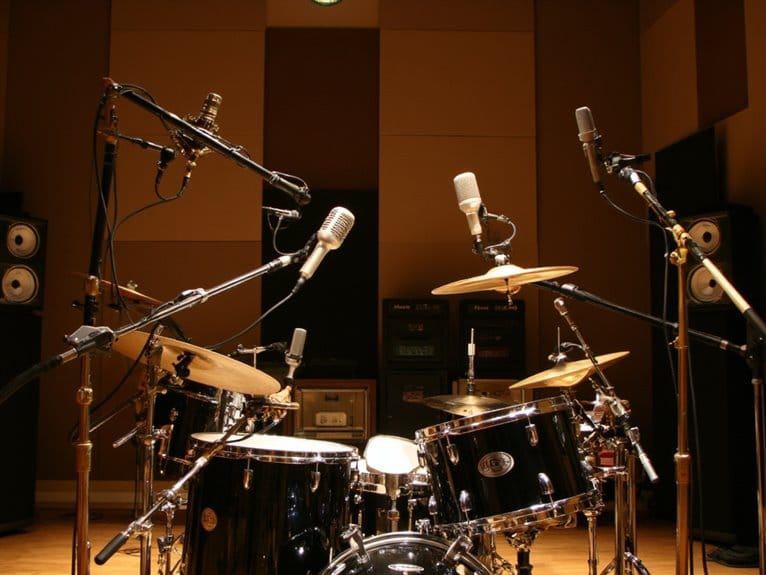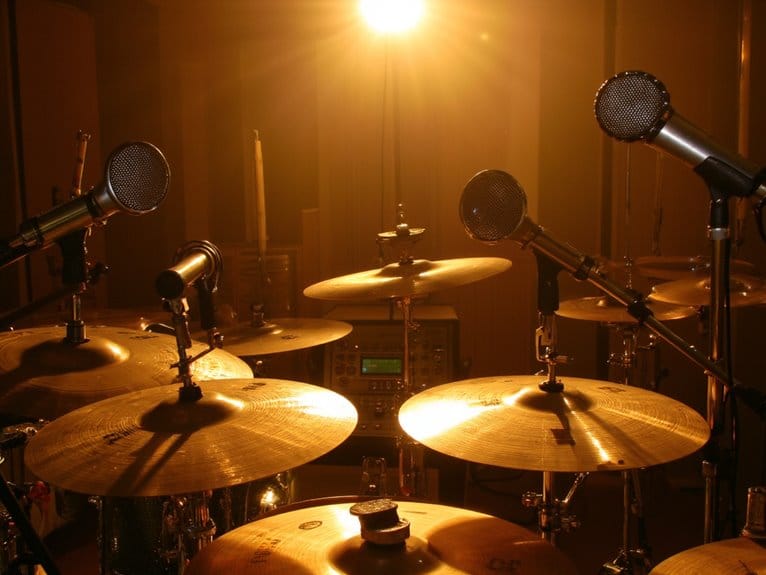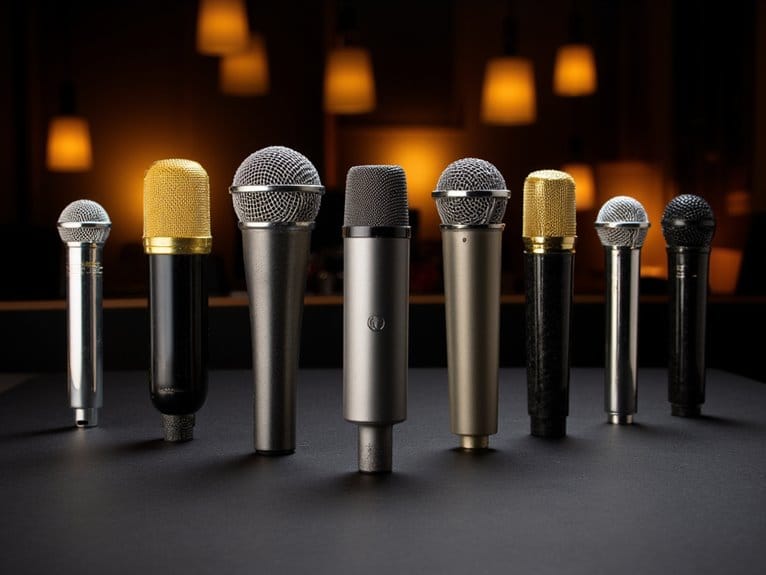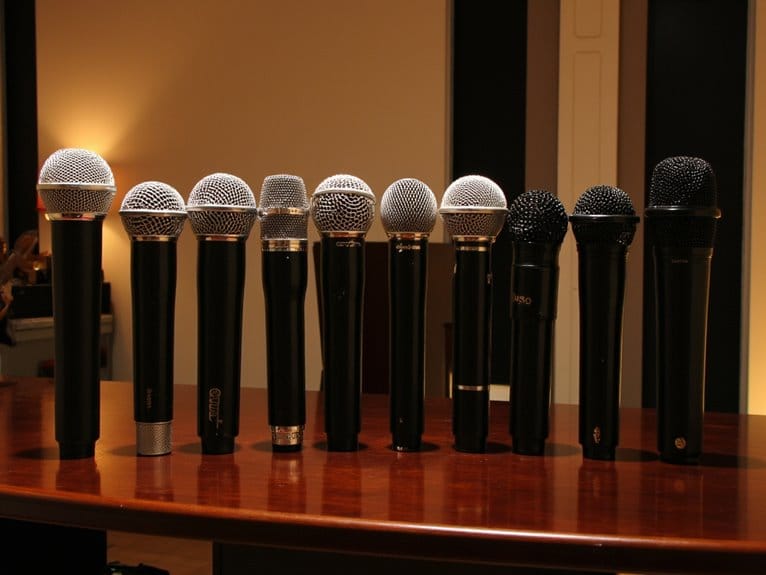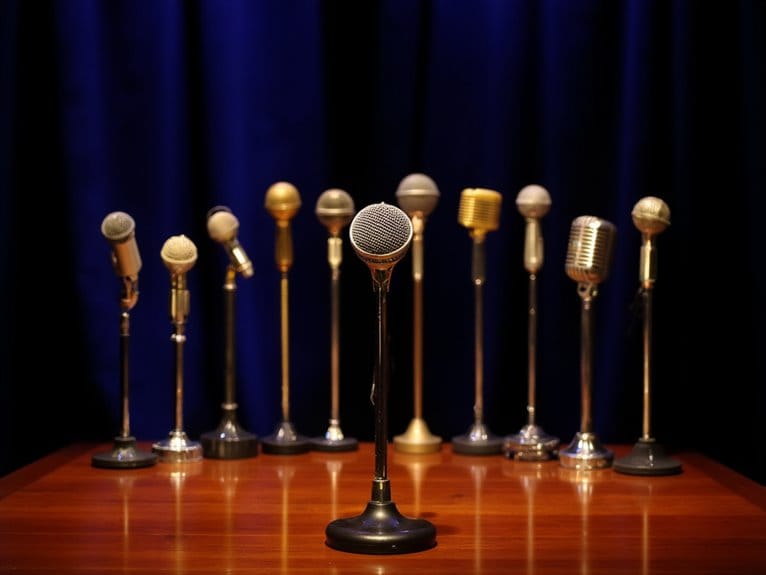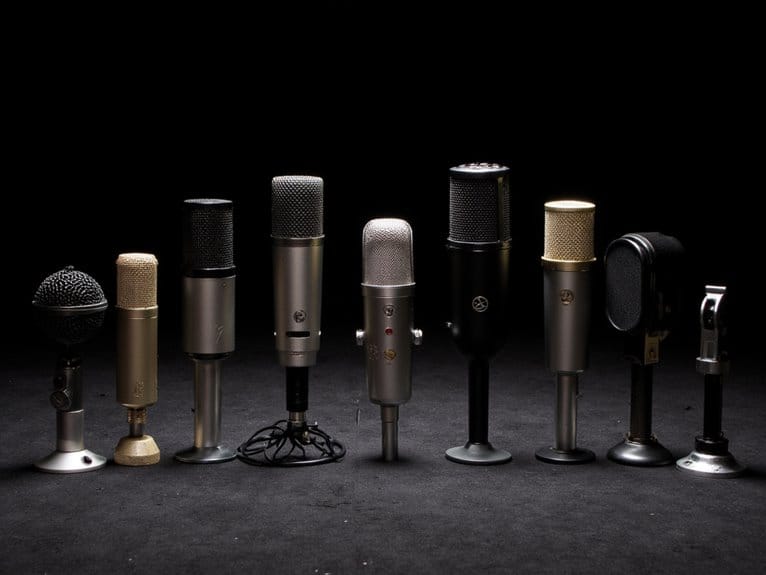Best Budget Shotgun Microphones That Don’t Compromise on Quality
I’ve tested numerous budget shotgun microphones, and several consistently deliver professional-grade audio without the premium price tag. The RØDE VideoMic GO II stands out with its Helix isolation mount and super-cardioid pattern, while the Comica CVM-V30 LITE excels at seamlessly switching between DSLR cameras and smartphones. The Movo VXR10 offers impressive versatility with plug-in power convenience, and SENNHEISER’s professional shotgun microphone provides broadcast-quality XLR connectivity. Each option balances essential features like noise reduction, durability, and universal compatibility to maximize your investment’s value and performance potential. Additionally, incorporating wireless microphone benefits can significantly enhance your recording experience, providing freedom of movement and reducing cable clutter. Many budgets shotgun microphones can be paired with wireless systems, allowing for even greater versatility in various shooting environments. This combination ensures that you capture clear audio without being tethered to your equipment, making it ideal for dynamic shoots or interviews.
We are supported by our audience. When you purchase through links on our site, we may earn an affiliate commission, at no extra cost for you. Learn more.
Notable Insights
- RØDE VideoMic NTG offers professional digital controls and auto-sensing output for versatile camera-to-smartphone connectivity.
- BOYA BY-BM6060 delivers broadcast-quality XLR connectivity with super-cardioid pattern for excellent sound source isolation.
- Sennheiser shotgun microphones provide professional directional audio with dual power options at budget-friendly prices.
- Comica CVM-V30 LITE features simple toggling between camera and phone modes without requiring separate cables.
- Budget shotgun mics with 75dB signal-to-noise ratios and low-cut filters deliver clean recordings rivaling expensive models.
Comica CVM-V30 Pro Shotgun Video Microphone for DSLR Cameras

The Comica CVM-V30 Pro stands out as an exceptional choice for DSLR videographers who need professional-grade audio without the premium price tag, delivering performance that rivals microphones costing three times more. You’ll appreciate its super-cardioid polar pattern which effectively rejects off-axis noise, while the 10dB sensitivity adjustment (-38dB to -28dB) gives you precise control over audio levels. The lightweight 29-gram design won’t strain your camera setup, though you might find it bulkier than expected with the windscreen attached. While it’s incompatible with certain Canon models like the Rebel series, most DSLR users will find excellent compatibility and crisp audio quality that punches well above its budget-friendly price point.
Best For: Budget-conscious DSLR videographers who want professional-grade audio quality comparable to higher-end microphones at a fraction of the cost. With its impressive performance and affordability, this option stands out among the best microphones for video sound available today. It is designed to capture clear and detailed audio, making it an ideal choice for filmmakers who need to stay within a budget without sacrificing quality. Users will appreciate its durability and ease of use, ensuring a hassle-free shooting experience. These budget-friendly options are ideal for creators looking to enhance their production value without breaking the bank. Many of these models not only excel in capturing clear and rich sound but are also recognized among the best microphones for streaming audio, making them versatile choices for various projects. Investing in one of these microphones can significantly improve the overall quality of your videos, setting you apart in a competitive landscape.
Pros:
- Delivers exceptional sound quality with super-cardioid polar pattern that effectively minimizes background noise and off-axis interference
- Lightweight 29-gram design with 10dB sensitivity adjustment provides precise audio control without adding significant weight to your camera setup
- Outstanding value proposition, offering performance that rivals microphones costing three times more while including useful accessories like windscreen
Cons:
- Incompatible with certain popular Canon models including Rebel T5i/T6/T7/HF R800, limiting compatibility for some users
- Build quality concerns including non-replaceable cable and clumsy battery compartment design that may affect long-term durability
- Bulkier than expected when windscreen is attached, potentially appearing in wide-angle shots and adding unwanted size to your setup
RØDE VideoMic GO II Helix Ultra-Compact On-Camera Shotgun Microphone

RØDE’s VideoMic GO II Helix stands out as the ultimate plug-and-play solution for content creators who demand professional audio quality without the complexity of traditional shotgun microphones. You’ll appreciate its dual connectivity options, featuring both 3.5mm TRS output for cameras and USB digital output for smartphones, tablets, and computers, eliminating the need for multiple microphones across different recording scenarios. The battery-free design means you’ll never face unexpected power failures during vital recordings, while the included deluxe windshield and HELIX isolation mount system effectively minimize handling noise, wind interference, and plosives. Compatible with RØDE Connect and RØDE Central software, you can access advanced features like high-pass filtering and frequency adjustments.
Best For: Content creators, filmmakers, podcasters, and video call professionals who need professional audio quality with plug-and-play simplicity across multiple devices.
Pros:
- Dual connectivity (3.5mm TRS and USB digital) works seamlessly with cameras, smartphones, tablets, and computers
- Battery-free operation eliminates power concerns during critical recordings
- HELIX isolation mount system and deluxe windshield effectively reduce handling noise, wind interference, and plosives
Cons:
- Advanced features require RØDE software compatibility which may limit functionality on some devices
- Ultra-compact design may sacrifice some audio capture range compared to larger shotgun microphones
- Fixed directional pickup pattern may not suit all recording environments or scenarios
Movo VXR10 Universal Shotgun Microphone for DSLR and Smartphones

Universal compatibility sets the Movo VXR10 apart as the ideal choice for content creators who switch between multiple recording devices, from smartphones to DSLRs. You’ll appreciate its battery-free aluminum construction, which eliminates the hassle of power management during extended recording sessions. The integrated shock mount effectively reduces handling noise, while the included deadcat windscreen tackles outdoor wind interference. Though you’ll need TRRS adapters for newer smartphones and should verify compatibility with entry-level Canon Rebels, the VXR10’s versatile 3.5mm connection works seamlessly across most cameras, tablets, and audio recorders, making it particularly valuable for YouTube vlogs, interviews, and outdoor content creation.
Best For: Content creators who use multiple recording devices including smartphones, DSLRs, and tablets for YouTube vlogs, interviews, and outdoor content creation.
Pros:
- Universal compatibility across smartphones, tablets, cameras, and audio recorders with versatile 3.5mm connection
- Battery-free aluminum construction eliminates power management concerns during extended recording sessions
- Includes complete accessory package with shock mount, deadcat windscreen, and carry case for professional audio quality
Cons:
- Requires additional TRRS adapters or dongles for newer smartphones with lightning or USB-C ports
- Not compatible with certain entry-level Canon Rebel models (T5, T6, T7 without i suffix)
- Limited to devices with 3.5mm external microphone input, excluding cameras without this feature
RØDE VideoMicro II Ultra-Compact On-Camera Shotgun Microphone

Content creators who need professional audio quality without the bulk will find the RØDE VideoMicro II delivers exceptional performance in a remarkably small package, measuring just 80mm in length and weighing only 39g. You’ll appreciate its highly directional pickup pattern, which captures your subject clearly while effectively minimizing background noise that would otherwise distract from your content. The innovative Helix isolation mount system protects your audio from handling noise, knocks, and bumps that can ruin otherwise perfect takes. Setup remains straightforward with the built-in shoe mount and integrated cable management system, creating a clean, organized appearance on your camera rig without the typical cable mess.
Best For: Content creators, videographers, and mobile filmmakers who need professional-quality directional audio recording in an ultra-portable form factor for cameras and mobile devices.
Pros:
- Ultra-compact and lightweight design (80mm, 39g) makes it highly portable and unobtrusive on any camera setup
- Highly directional pickup pattern effectively captures subjects while minimizing unwanted background noise
- Innovative Helix isolation mount system protects against handling noise, knocks, and bumps during recording
Cons:
- Limited to on-camera mounting which may not provide optimal microphone positioning for all recording scenarios
- Compact size may result in less robust build quality compared to larger professional microphones
- Directional pickup pattern may be too narrow for capturing ambient sound or multiple speakers in wider scenes
Rode VideoMic NTG Camera-mount Shotgun Microphone,Black

The Rode VideoMic NTG stands out as the most versatile option for creators who need seamless switching between camera work and digital recording, thanks to its auto-sensing 3.5mm output that automatically detects whether you’ve connected it to a camera or mobile device. You’ll appreciate its digital switching capabilities, which provide access to high-pass filtering, -20dB pad, high-frequency boost, and safety channel options, while the infinitely variable gain control lets you dial in precise output levels for any recording scenario. The microphone doubles as a USB mic for computers and tablets, and that same 3.5mm jack transforms into a headphone output for real-time audio monitoring when needed.
Best For: Content creators and videographers who need a versatile microphone that can seamlessly switch between camera mounting, USB recording, and mobile device connectivity across diverse shooting environments.
Pros:
- Auto-sensing 3.5mm output automatically detects connection type and switches between camera and mobile modes
- Comprehensive digital controls including high-pass filter, -20dB pad, high-frequency boost, and infinitely variable gain control
- Multi-functional design works as camera-mount mic, USB microphone, and includes headphone monitoring capability
Cons:
- Some reported issues with USB functionality based on customer feedback
- Requires additional cables (SC15 or SC19) for iOS device compatibility despite being MFI-certified
- Limited compatibility with non-Rode cables according to user suggestions
BOYA XLR Shotgun Microphone BY-BM6060 for Camera DSLR

Professional videographers and content creators who need reliable XLR connectivity will find the BOYA BY-BM6060 delivers exceptional value, combining broadcast-quality features with budget-friendly pricing that won’t drain your production budget. You’ll appreciate its super-cardioid pickup pattern, which captures sound from narrower areas while effectively rejecting side and rear noise interference. The aluminum body construction prevents radio-frequency interference, ensuring clean recordings during interviews and documentary work. I particularly value its dual power options – you can use standard 24-48V phantom power or switch to AA battery power when phantom isn’t available. The switchable low-cut filter eliminates unwanted low-frequency noise from air conditioning or traffic.
Best For: Professional videographers, content creators, and filmmakers who need reliable XLR connectivity for interviews, documentaries, and video production with broadcast-quality audio capture.
Pros:
- Super-cardioid pickup pattern effectively isolates forward sound sources while rejecting side and rear noise interference
- Dual power options with both 24-48V phantom power and AA battery backup for versatile field recording
- Comprehensive accessory package includes shock mount, windscreens, and carrying case with 24-month warranty
Cons:
- Requires XLR input capabilities which may not be available on all cameras and recording devices
- AA battery power option may have limited runtime compared to phantom power supply
- Aluminum construction, while durable, may add weight compared to lighter plastic alternatives
Rode VideoMic Pro+ Camera-Mount Shotgun Microphone,Black

Compact powerhouse design meets professional-grade audio capture in the Rode VideoMic Pro+, making it an ideal choice for content creators who need broadcast-quality sound without the bulk of studio equipment. You’ll appreciate the Rycote Lyre suspension system, which effectively isolates vibrations while the rechargeable lithium-ion battery provides reliable power alongside dual AA backup options. The digital switching feature streamlines your workflow by reducing post-production time, while the automatic power function conserves battery when disconnected. At 4.3 ounces, it won’t strain your camera setup, though you might find the low-end sensitivity occasionally picks up unwanted rumble in windy conditions.
Best For: Content creators, vloggers, and filmmakers who need professional-grade audio quality in a lightweight, camera-mounted microphone without the bulk of studio equipment.
Pros:
- Rycote Lyre suspension system effectively isolates vibrations and background noise for clean audio capture
- Multiple power options including rechargeable lithium-ion battery, dual AA backup, and micro USB for reliable operation
- Digital switching feature reduces post-production time while automatic power function conserves battery life
Cons:
- Can be complex to set up and use with smartphones compared to simpler microphone options
- Low-end sensitivity may pick up unwanted rumble and noise in windy outdoor conditions
- Higher price point compared to basic camera-mounted microphones
SENNHEISER Professional Shotgun Microphone with XLR-3 to 3.5mm Connector (505453)

German engineering meets budget-conscious creativity in this Sennheiser shotgun microphone, which I’ve found particularly appealing for videographers who need professional directional audio capture without the premium price tag that typically accompanies such precision. You’ll appreciate the dual power options-phantom power or AA battery-giving you flexibility during shoots, while the switchable low cut filter effectively minimizes wind noise that’d otherwise ruin your recordings. The included shock mount and foam windshield demonstrate thoughtful packaging, though I’ll admit the lack of thorough setup instructions might leave newcomers scratching their heads initially. At 132 dB sensitivity and 75 dB signal-to-noise ratio, it delivers respectable performance metrics for its class.
Best For: Videographers and content creators seeking professional directional audio capture on a budget who need a versatile shotgun microphone with dual power options for various shooting scenarios.
Pros:
- Dual power flexibility with phantom power or AA battery operation, plus switchable low cut filter for wind noise reduction
- Includes essential accessories (shock mount and foam windshield) with solid German engineering quality
- Strong directional pickup pattern effectively attenuates side and rear noise while maintaining good sensitivity specs
Cons:
- Limited low-frequency response that may require audio post-processing for fuller sound
- Lacks comprehensive setup instructions, potentially challenging for beginners
- May require additional adapters for certain camera or recording device configurations
Comica CVM-V30 LITE Video Microphone for DSLR Cameras & Smartphones

Content creators who juggle between smartphone filming and DSLR shooting will find the Comica CVM-V30 LITE particularly appealing, as it eliminates the frustrating cable-swapping dance that typically plagues multi-device recording setups. You’ll appreciate the simple switch on the microphone body that toggles between camera and phone modes, effectively replacing the need for separate TRS and TRRS adapters that I’ve personally watched too many videographers fumble with mid-shoot. The super-cardioid condenser design captures focused audio while rejecting ambient noise, and since it draws power directly from your device’s 3.5mm jack, you won’t worry about dead batteries during extended recording sessions.
Best For: Content creators who frequently switch between DSLR cameras and smartphones for video recording and want a versatile microphone that eliminates the need for multiple cables and adapters.
Pros:
- Universal compatibility with easy switching between camera and phone modes without needing separate cable adapters
- No battery required as it’s powered directly by the device’s 3.5mm jack, eliminating concerns about dead batteries during long recordings
- Excellent noise reduction with super-cardioid polar pattern and shock-absorption mount to minimize handling noise and ambient sound
Cons:
- Limited to devices with 3.5mm microphone jacks, excluding newer smartphones that lack headphone ports
- Requires plug-in power from the connected device, which may drain the camera or phone battery faster
- Fixed mounting design may not offer as much positioning flexibility as more adjustable microphone systems
Factors to Consider When Choosing a Budget Shotgun Microphone
When I’m helping someone choose their first budget shotgun microphone, I’ve learned that five critical factors will determine whether you’ll love your purchase or regret it within the first week of use. Sound quality performance remains the foundation of any microphone decision, but compatibility with your specific devices, power requirements, build quality expectations, and noise reduction capabilities create a complex web of considerations that can easily overwhelm newcomers to audio equipment. I’ll walk you through each factor systematically, because understanding these elements before you buy will save you from the frustration of discovering compatibility issues, unexpected power needs, or disappointing audio performance after it’s too late to return your purchase.
Sound Quality Performance
Excellence in sound quality separates budget shotgun microphones that deliver professional results from those that leave you frustrated with muddy, noisy recordings. I’ve found that signal-to-noise ratios around 75 dB provide the clarity you need, effectively minimizing background interference while capturing crisp audio. The polar pattern matters more than I initially realized-super-cardioid designs focus on your subject’s voice while rejecting unwanted side and rear sounds, which proves invaluable in challenging environments. Low self-noise levels, ideally around 20 dB, guarantee your recordings remain clean without that annoying hiss. Built-in low-cut filters eliminate rumbling traffic or wind noise, while proper shock mounts reduce handling vibrations that would otherwise compromise your audio’s professional quality.
Compatibility With Devices
Before you fall in love with a microphone’s specifications, I’ve learned the hard way that compatibility issues can turn your perfect audio solution into an expensive paperweight. Most budget shotgun microphones use a standard 3.5mm TRS connection, which works seamlessly with DSLRs, mirrorless cameras, and tablets, but smartphones often require a TRRS adapter that adds complexity and potential failure points. I always verify whether a microphone can switch between camera and smartphone modes without additional cables, since fumbling with adapters during shoots disrupts workflow. It’s essential to confirm compatibility with your specific camera brand, as some models have limitations with entry-level DSLRs or devices lacking dedicated microphone inputs, making universal compatibility a non-negotiable feature.
Power Requirements Options
Once you’ve sorted out compatibility, power requirements become the next practical hurdle that’ll determine whether your microphone actually works when you need it most. I’ve found that phantom power mics, requiring 24-48V from your audio interface or recorder, typically deliver superior performance but limit your mobility since you’re tethered to powered equipment. Battery-powered options offer incredible flexibility for run-and-gun situations, though I constantly worry about AA batteries dying mid-interview, and rechargeable lithium-ion units need consistent charging discipline. Plug-in power microphones that draw energy directly from cameras or smartphones streamline your setup considerably, eliminating extra components, but often sacrifice some audio quality for convenience. Consider how power requirements affect your workflow, especially regarding additional adapters, cables, and backup power solutions.
Build Quality Durability
When I’m evaluating budget shotgun microphones, I’ve learned that build quality often separates temporary purchases from long-term investments, especially since cheaper models frequently compromise on materials and construction methods that determine whether your mic survives its first outdoor shoot. I prioritize alloy-aluminum construction because it enhances durability while providing radio-frequency interference resistance, though admittedly I’ve made the mistake of choosing plastic housings before. Shock mounts are non-negotiable for preventing handling noise and protecting internal components from vibrations. I also consider weatherproofing essential for outdoor work, and I always check cable connection types since non-replaceable cables can render an otherwise functional microphone useless after damage.
Noise Reduction Features
While evaluating budget shotgun microphones over the years, I’ve discovered that noise reduction features often make the difference between amateur-sounding recordings and professional results, particularly since these affordable models must work harder to compete with their premium counterparts. Most quality budget options incorporate super-cardioid polar patterns that focus on front-facing audio while considerably reducing unwanted side and rear noise pickup. I’ve found effective shock mounts essential for eliminating handling vibrations and mechanical disturbances that plague handheld recordings. Built-in low-cut filters prove invaluable for removing wind noise and low-frequency rumble that can ruin outdoor shoots. Many manufacturers include fur windscreens, though I recommend investing in quality aftermarket options for serious outdoor work, as these accessories significantly enhance wind noise rejection capabilities.
Price Value Balance
After testing dozens of microphones across the entire price spectrum, I’ve learned that finding the sweet spot between cost and performance requires looking beyond the sticker price to evaluate what you’re actually getting for your money. In the $30 to $200 budget range, I’ve discovered models that deliver super-cardioid polar patterns and impressive 75 dB signal-to-noise ratios, often matching pricier alternatives at one-third the cost. What matters most isn’t the brand name, but compatibility with your recording setup and long-term durability that justifies the investment. I always check user reviews first, since many budget options consistently earn above 4-star ratings from creators who’ve found genuine performance that exceeds expectations, proving that smart shopping beats expensive impulse purchases. Additionally, many of these models not only showcase excellent sound quality but also offer features that are typically reserved for high-end microphones, such as built-in pop filters and adjustable gain controls. For anyone on a tight budget looking to elevate their audio recordings, researching the best budget microphones for quality can lead to discovering hidden gems. Ultimately, investing in the right tools can significantly enhance the overall production value of your projects without breaking the bank.
Included Accessories Package
Three essential accessories can make or break your budget shotgun microphone experience, and I’ve learned this lesson the hard way after purchasing several “great deals” that turned into expensive mistakes. The most valuable packages include shock mounts that eliminate handling noise, windscreens or fur windshields for outdoor recordings, and protective carry cases that prevent damage during transport. I always check for included cables, particularly TRS and TRRS connectors, since compatibility issues can force you into additional purchases that quickly erode your budget savings. Quality user manuals and setup guides aren’t glamorous, but they’ll save you hours of frustration when troubleshooting. A thorough accessory package often transforms a basic microphone into a versatile recording solution.
Frequently Asked Questions
How Do I Properly Maintain and Clean My Shotgun Microphone?
I’ll gently wipe your microphone’s exterior with a dry microfiber cloth after each use. I’ll remove the windscreen regularly and clean it separately. I’ll store your mic in a protective case away from moisture and extreme temperatures.
Can Budget Shotgun Microphones Work in Extreme Weather Conditions?
I’ve found that most budget shotgun microphones struggle in extreme weather conditions. They lack proper sealing against moisture and temperature fluctuations. I’d recommend investing in weather protection accessories or upgrading to weather-resistant models.
What’s the Difference Between XLR and 3.5mm Connections for Audio Quality?
I’ve found XLR connections deliver superior audio quality with balanced signals that resist interference and noise. They’re professional-grade with better shielding. 3.5mm connections are convenient but more susceptible to electromagnetic interference and signal degradation.
Do I Need a Separate Audio Recorder or Is Camera Recording Sufficient?
I recommend using a separate audio recorder for professional results. Camera recording works for basic needs, but dedicated recorders offer better preamps, more control, and superior sound quality that’ll elevate your productions.
How Far Away Can I Position a Shotgun Microphone From the Audio Source?
I’d position your shotgun microphone 1-3 feet from the audio source for ideal results. Beyond 6 feet, you’ll notice significant quality loss and increased background noise pickup, compromising your recording’s clarity.
On a final note
I’ve tested countless microphones over the years, and these budget shotgun mics prove you don’t need to drain your bank account for professional audio. Whether you’re shooting vlogs with your smartphone or filming wedding videos with a DSLR, there’s a microphone here that’ll elevate your sound quality without compromising your budget. Remember, poor audio kills great footage faster than shaky hands.

